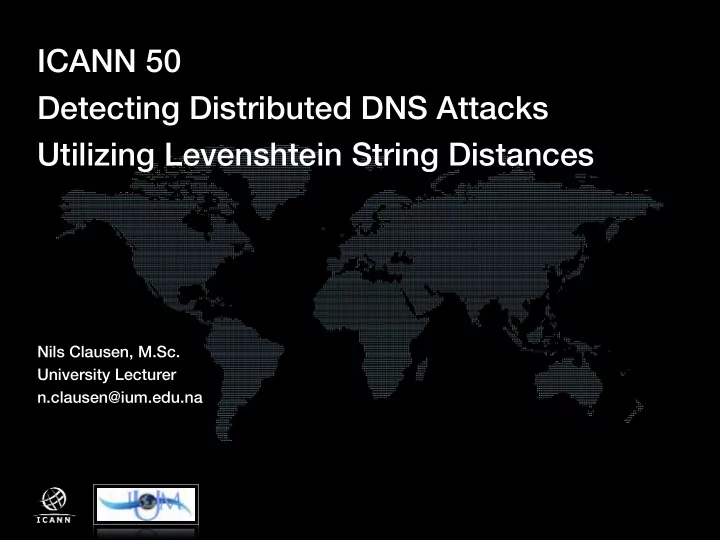

ICANN 50 Detecting Distributed DNS Attacks Utilizing Levenshtein String Distances � � � � � Nils Clausen, M.Sc. University Lecturer n.clausen@ium.edu.na
Detecting Distributed DNS Attacks Utilizing Levenshtein String Distances Context Statement of the Problem Assumptions The Levenshtein String Distance Measure Proposed Solution Sample Result Set Technical Advice for Implementation
Context � • NA-NIC has turned on the protocol option on their name servers • the protocol data gets replicated into a relational database (MariaDB) • table na_log then contains all name server queries with timestamp (down-to-the-second granularity), client ip/ port, query name
Statement of the Problem � • NA-NIC has noticed attacks (suspicious queries) on their name servers, possibly caused by bots/viruses and misconfiguration of client networks • Spikes in query numbers are detected for certain days • Attacks are not only originating from an easily detectable, uniform range of clients • Different character permutation techniques seem to be in use by attackers, that makes simple substring comparisons useless for detection
Assumptions • Suspicious queries: • occur only a small number of times per distinct string • are systematic and show signs of “somewhat” similarity • can be issued from various clients (even at the same time) • do not necessarily produce a peak in the number of queries • Query names, that exactly match registered domains are considered to be legitimate and can therefore be excluded from analysis
The Levenshtein String Distance Measure • A string metric for measuring the difference between two sequences, i.e. the minimum number of single-character edits (insertions, deletions or substitutions) to transform one sequence into another • Levenshtein, Vladimir I. (1966). "Binary codes capable of correcting deletions, insertions, and reversals". Soviet Physics Doklady • N.B.: used by search engines for suggestions when typing errors are suspected • Demo: http://odur.let.rug.nl/~kleiweg/lev/
Proposed Solution • Take na_log as a basis, attributes query_timestamp, client_ip and query_name are of primary interest • Do pairwise calculation of Levenshtein distances between all query_name combinations with same length • Limit pairwise calculation to Levenshtein ratios (Levenshtein distance ÷ length of string) > 0 and < 0.3 (to exclude same-string comparisons and only include strings with high- to medium similarity) • Derive aggregate attributes day, month, year from query_timestamp for further analysis capabilities • Further calculations can be performed on result set, e.g. correlation metrics for cluster analysis
Illustration of Proposed Solution na_log ¡view ¡with ¡query ¡ strings na_log ¡ na_log ¡ na_log ¡ cross-‑sections ¡contain ¡ table ¡ view ¡ table ¡ pairwise ¡calculation ¡of ¡ 1:1 ¡ join ¡ with ¡ with ¡ with ¡ view both Levenshtein ¡distance ¡ query ¡ query ¡ query ¡ measures ¡ strings strings strings
Sample Result Set query ¡string comparison ¡query ¡string malicious ¡client medium ¡similarity
Sample Result Set: Further Analysis red: ¡high-‑volume ¡malicious ¡clients, ¡ identified ¡by ¡group-‑by ¡statement ¡ on ¡result ¡set
Range of Levenshtein Ratios in Sample Set
Technical Advice for Implementation • Pairwise comparison implies exponential cardinality of result sets and long running calculation times • Either limit input to a few hours or days of logs based on database performance, or use in-memory database technology • Use materialized views or tables to store intermediate result sets for faster access when using non-in-memory databases
Technical Advice for Implementation • Download levenshtein.c • Compile as per the file • Install into MariaDB/MySQL Plugin Directory • CREATE FUNCTION levenshtein RETURNS INT SONAME 'levenshtein.so';
Thank You. Questions?
Recommend
More recommend